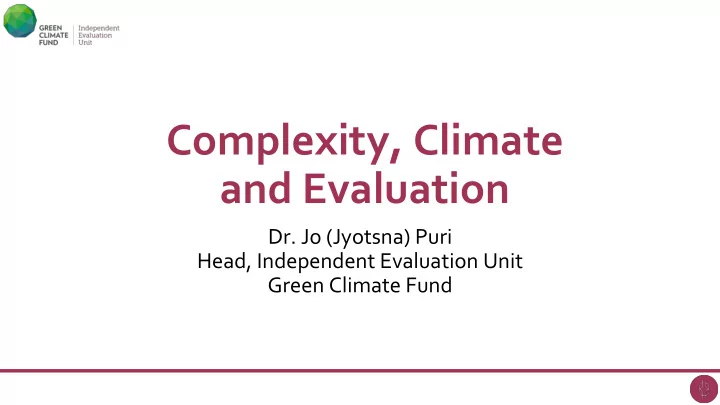

Complexity, Climate and Evaluation Dr. Jo (Jyotsna) Puri Head, Independent Evaluation Unit Green Climate Fund
What do we see?
How does this work? • Ants work together despite not having a leader telling them what to do • decentralized signaling and self- organization. • Ants change their behavior based on what they see others doing • adaptive interaction • The whole (fire ant bridge) is greater than the sum of its parts (individual ants) • Emergence!
Emergence : The fundamental characteristic of Complex Systems
Complex vs. Complicated • Multiple moving parts • Parts work together in a network to produce an outcome • System adapts to its environment Complicated is • Agents communicate in a decentralized way not those things • Potential for unpredictable behaviour
Complexity and climate change? • Climate patterns are complex! • Climate change project is a complex system • Multiple stakeholders • Potential for secondary effects • Shifting baselines with changing climate • Feedbacks to reinforce trends • Tipping points – ecological collapse?
Two main questions Can we measure the complexity in climate change projects? What does complexity mean for evaluating climate change programs?
What we did • Qualitative analysis of 10 random project proposals • Evaluability, complexity, proposed evaluation design • Rubric to rate levels of complexity • Based on proxy indicators • Literature review of complexity and evaluation • Suggests methods for evaluation and identifies gaps
What we found: Qualitative Proposal Analysis • Theories of Change weak . • More interventions, more potential for confounding amongst them and unexpected outcomes. • Mitigation-only projects not as complex as adaptation or both • Potential for evaluation if proper steps. • Measure institutional and policy interventions?
THE COMPLEXITY RUBRIC
What we found: Complexity Rating • Project complexity: 3 high, 6 medium, 1 low • More interventions = more complexity • Limited by proxies • Limited to what is written in project proposal.
Examining complexity • Learning-oriented real- time impact assessment programme (LORTA) • Sustainable landscapes in Madagascar • Collaboration between private and public sector (Conservation International and EIB) • Forest corridors
MADAGASCAR- OBJECTIVES • Increase resilience of vulnerable farmers (85700 farmers) • Reduce GHG emissions from deforestation and forest degradation (680000 ha of forests; 5 MtCO2 ) • Protect forests • Improve access to energy with low emission electricity (448000 farmers) • May 2018 – May 2022 (public sector) and till 2027 for private sector.
GIS Data beforehand
2019: 2020 2021 2022 2023 Year 0 Year 1 Year 2 Year 3 Year 4 Phase 1 (59 COBAs) Data collection HH data 14 households per Total: 826 hhs No data 826 finished 826 finished by 826 finished by 826, four times = collection COBAs. collection by April April April 3304 (survey data) COBAs phase 1: 59 observations Training and Starts in Year 0 Continues Continues Continues Continues and Interventions distribution after data completed Patrolling collection before year 5 AFTER year 0 Monitoring Starts in Year 0 Continues Continue Continues Continues and (high and continues completed Qualitative data frequency through the before year 5 data) and GIS. year AFTER data collection collection in Year 0 Phase 2 (59 COBAs) HH data COBAs phase 2: 59 No hh data No hh data No hh data No hh data No hh data 0 collection CAZ: collection collection collection collection collection COFAV: HH data Collect data on None None Collect data in Collect data in 826 x 3 times = collection 826 826 826 2478 (hh survey) households households in households in observations Comparison April April Total obs. For 178 (Phase 1: 826 0 Phase 1: 826 Phase 1: 826 Phase 1: 826 8177 household Phase 2: 0 Phase 2: 0 Phase 2: 0 Phase 2: 0 sites and design data collection Phase 3: 826 Phase 3: 0 Phase 3: 0 Phase 3: 0 Outside: 826) Outside: 826 Outside: 826 Outside: 826
What we found (aligned with the literature) • What does high complexity mean for evaluation? • We might not be able to capture important changes – simplistic theories of change. • Different methods, more methods? • Most suggested methods are qualitative – what does it mean for rigorous causal inference ? • There isn’t much literature on complexity and evaluation; for climate change there is even less
Learning for design and implementation till now ▪ Outcomes are emergent properties of complex systems ▪ Adaptive experimentation. ▪ Results based payments? ▪ Let the experts implement and design.
Ideas for a path forward • Useful framework of analysis? • How to better identify and measure complexity? • New approaches for understanding complex projects • R eal-time learning • Innovation with technology: GIS, CIS, wearables, mobile data, apps • Innovation with methods: Econometrics like synthetic control; machine learning for predictive inference
Thank you! Contact IEU: ieu@gcfund.org @GCF_Eval ieu.greenclimate.fund TRUSTED EVIDENCE . INFORMED POLICIES . HIGH IMPACT .
A Rhino bond - Results based payments - Let the experts implement and design. - Adaptive experimentation. - Outcomes are emergent properties of complex systems
Recommend
More recommend